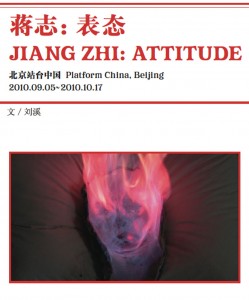蒋志:表态 JIANG ZHI: ATTITUDE
 文/刘溪 Text/Liu Xi
文/刘溪 Text/Liu Xi
从2009年9月开始,“表态”辗转在上海、香港、北京三地,是蒋志展出作品时间跨度最长、规模最大的一次系列个展。在系列展览中,蒋志用影像、装置、绘画等多种手段集中表达了当代社会中“主体的修辞学”、“身体与政治的关系”。三站展览中,几件影像作品如《娇羞的、太娇羞的》、《颤抖》、《0.7%的盐》贯穿始终,而《谢幕》、《对不起》则出现在香港、北京的展览;而2010年新做的雕塑《肱二头肌主义》与影像作品《长眠》也在最近的这次北京的展览上展出。
展览中最引人注目的无疑是几部影像作品。影像是蒋志比较偏爱使用的媒介,原因大概在于其介入感更直接、造成的冲击力也更强烈。这些作品大多取材或灵感来自于真实的社会公共事件。比如展厅入口处的《长眠》,那张静静燃烧着的人脸携带有一种奇异的美感,然而若知晓其背后的故事源头,观看快感则被迅速扭曲。蒋志在此有效地利用、模仿了一个鲁迅的看客观念,那桩事件当时的现场旁观者、听到这则新闻的人以及现在面对被艺术化处理的作品、在展览现场悠闲迈步的观看者,这三重的观看统统指向一种具有普遍意义的漠然。蒋志的目的正在于把玩这种心理,让观者意识到“看/旁观”这一行为本身之无情。这种对“看”的操纵,同样也出现在《0.7%的盐》中,但又多了几分对所谓“真实”的怀疑。蒋志似乎在套用某种现成的视觉逻辑来提醒我们注意所谓的“真实”是被建构出来的。
可见,蒋志对“社会”这个虚拟的权力集中体对自然人、个体性命的操控有着知性的敏感。他意识到意识形态对人操纵的最终效果是不露痕迹,并使被操纵者毫无知觉,表现为一种策展人鲍栋所提出的“修辞”,一种带修饰性并最终说服人的表达。这是蒋志如此偏爱利用媒体、公众人物、社会性事件的原因。对他来说,这些东西都构成修辞的表征。也因之,他勉力于借艺术“异化”之手段,使观看者自我醒觉。这一根本目的,几乎是他近期所有作品的初衷,也因之他的作品十分注重文学性的“装扮”。同样使用“陌生化”手段的《谢幕》出现在展厅深处,几乎所有人看到它时都能会心一笑。蒋志将“舞台”与“不愿下台的表演者”提纯,针对现实的语境,其作品的意指已经越出暗示的界定。而在七屏的影像作品《颤抖》中,社会景观中类似的境况被高度的象征化与符号化,使其不自然的本质如荧幕上的男女裸体一样裸露出来,而“剥离凸显”正是蒋志在这部作品使用的修辞。
在中文里,“表态”是一个强烈的动词。即便在展览前言中策展人一再强调,他们希望以名词的方式放入社会语境中来考察。然而,展览中的作品很难说不是蒋志本人的表态,其中强烈地蕴含着一种期待借此唤起公众表态的热情与希望。观众若可解读到这一层面,对蒋志来说,艺术的公共性效用才算得上是一次有效的实施。
Starting off in September 2009, Jiang Zhi’s solo outing “Attitude” passed from Shanghai to Hong Kong to Beijing in his largest scale, longest spanning exhibition yet. Jiang Zhi used video, installation, painting, and a variety of other methods to focus on the expression of the “rhetoric of the subject” and “the relationship between body and politic.”
The most eye-catching were without a doubt his video works. Video is Jiang Zhi’s favorite medium, as it allows for a more direct sense of involvement, and thus results in a more intense impact. For the most part, these works draw their material and their inspiration from actual public events. Eternal Sleep, at the exhibition entrance, is an example: a human face possesses a curious, radiant beauty as it is silently consumed by flames; but upon learning the story behind the work, observational delight quickly warps into something else. Here, Jiang Zhi effectively imitates and applies Lu Xun’s notion of the implicit cruelty of the disinterested “bystander.” The manipulation of the notion of “watching” similarly appears in 0.7% Salt, an extended video that shows the movie star Gillian Chung crying, but more so in terms of the suspicion of “truth.” Jiang Zhi seems to be mechanically applying a kind of readymade visual logic, in order to call our attention to the constructed nature of our so-called “reality.”
It is clear that Jiang Zhi has an intellectual sensitivity to “society,” this fictitious entity whose power is concentrated on the control of individual lives. He is aware of the ultimate result of ideological control: it leaves no visible trace, while simultaneously desensitizing those under its spell, rendering them thoughtless and feelingless. It manifests itself in the form of what curator Bao Dong proposes is a kind of “rhetoric”: a delivery dressed in excessive ornamentation and used as a means of persuasion. This is why Jiang Zhi likes to take material from the media, public figures, and societal events; as far as he is concerned, it is all emblematic of a kind of “rhetoric.” He takes great pains to use artistic “alienation” to bring observers into greater self-awareness; this objective is the fundamental intention behind just about all of his recent works, and is the reason for Jiang Zhi’s weighted emphasis on literary “disguise.” Curtain Call, situated in the depths of the exhibition hall, also employs methods of “estrangement.” Anyone would smile at the sight of it; Jiang Zhi distills “the stage” and the entertainers who are unwilling to step down from it into their purest forms; as for the real-world context that it means to call out, the work far exceeds the bounds of the implicit in making its point. Next, in the seven-screen video work, Tremble, similar circumstances are dealt with again, this time in terms of the greater social landscape. The conditions of the piece are subject to a high degree of signification and symbolization; the very overuse of signs and symbols serves to expose their underlying contrivance. Just as with the nude men and women on the screen, “strip away and reveal” is the key “rhetoric” Jiang Zhi highlights in this piece.
In Chinese, the idea of “voicing an attitude” (biaotai) from which the exhibition takes its title is a powerful one. Though the curators, in their preface to the exhibition, repeatedly stress their desire to access and examine the social context through the use of terms, the pieces in this exhibition are pure Jiang Zhi. The intensity of this body of work indicates a kind of hopeful enthusiasm, the wish to take this opportunity to appeal to the attitude of general public. As far as Jiang is concerned, if his audience can read into his work at this level, then and only then is his work effective.